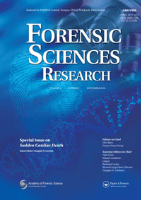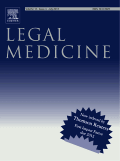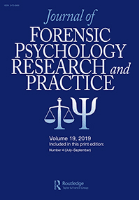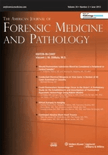
INTERNATIONAL JOURNAL OF LEGAL MEDICINE
Scope & Guideline
Bridging Disciplines: Where Law Meets Medicine
Introduction
Aims and Scopes
- Forensic Age Estimation:
Research in this area includes methodologies and techniques for estimating the age of individuals based on various biological markers, imaging techniques, and dental studies. - Molecular and Genetic Analysis:
This includes advancements in forensic DNA analysis, including sequencing technologies and the use of genetic markers for personal identification and kinship testing. - Toxicology and Drug Analysis:
Studies focusing on the detection and analysis of substances in biological samples, understanding drug-related fatalities, and the implications of drug use in legal contexts. - Postmortem Examination Techniques:
Research that enhances the methodologies for postmortem examinations, including autopsy practices, imaging technologies like CT and MRI, and novel techniques for assessing cause of death. - Forensic Anthropology and Odontology:
This area encompasses studies on human skeletal remains, dental identification, age estimation, and the application of anthropological techniques in forensic contexts. - Legal and Ethical Issues in Forensic Medicine:
Papers addressing the intersection of law, ethics, and practice in forensic medicine, including the implications of findings in legal settings. - Innovations in Forensic Technology:
Research on the development and application of new technologies in forensic science, such as artificial intelligence and machine learning for forensic analysis.
Trending and Emerging
- Artificial Intelligence in Forensics:
There is a growing trend toward integrating artificial intelligence and machine learning techniques in forensic analysis, improving accuracy and efficiency in various applications. - DNA Methylation and Biomarkers:
Emerging research is focusing on the use of DNA methylation as a biomarker for age estimation and other forensic applications, highlighting the role of epigenetics in forensic science. - Multidisciplinary Approaches:
An increasing number of studies are adopting multidisciplinary approaches, combining insights from various fields such as biology, chemistry, and engineering to enhance forensic methodologies. - Postmortem Interval Estimation:
There is a heightened emphasis on developing innovative methods for accurately estimating the postmortem interval using metabolomics and other advanced analytical techniques. - Microbiome Analysis in Forensics:
Research exploring the role of the human microbiome in forensic identification is gaining traction, indicating a shift towards understanding microbial signatures in forensic contexts. - Focus on Child and Adolescent Forensic Issues:
There is an emerging focus on forensic issues related to children and adolescents, including age estimation and the implications of findings in legal proceedings.
Declining or Waning
- Traditional Forensic Pathology:
There has been a noticeable shift towards more innovative and technological approaches in forensic science, leading to a decrease in traditional forensic pathology studies. - Historical Case Studies:
Research focusing on historical or retrospective case studies is becoming less frequent as the journal emphasizes contemporary methodologies and emerging trends in forensic science. - General Toxicology Studies:
Specific studies on general toxicology without a direct forensic application are less common, as the focus shifts to drug-related fatalities and their implications. - Basic Forensic Anthropology:
Basic anthropological studies without advanced methodologies or applications in legal contexts seem to be waning as more complex and technologically driven studies gain traction.
Similar Journals

Egyptian Journal of Forensic Sciences
Advancing forensic knowledge for a just world.The Egyptian Journal of Forensic Sciences, published by the International Association of Law & Forensic Sciences, stands as a premier platform for scholarly communication in the fields of forensic science, law, and health-related social sciences. With an ISSN of 2090-536X and an E-ISSN of 2090-5939, this open-access journal, established in 2011, has garnered a reputation for its rigorous peer-review process and substantive contributions to the field. Housed in Switzerland, it boasts impressive metrics, achieving a Q2 ranking in Health (social science) and a stellar Q1 in Law, in addition to being recognized in Pathology and Forensic Medicine. With its articles accessible to a global audience, the journal encourages the exchange of innovative ideas and practices among researchers, professionals, and students who are dedicated to advancing the disciplines of forensic science and legal studies. As of 2023, it ranks in the 75th percentile in Social Sciences - Law and continues to influence both academic discourse and practical applications in the forensic domain.

INTERNATIONAL JOURNAL OF LAW AND PSYCHIATRY
Navigating the Confluence of Justice and Mental WellnessThe INTERNATIONAL JOURNAL OF LAW AND PSYCHIATRY, published by PERGAMON-ELSEVIER SCIENCE LTD, stands as a pivotal resource in the intersection of legal studies and psychological research. With an ISSN of 0160-2527 and E-ISSN 1873-6386, this journal covers a broad spectrum of topics from the complexities of mental health law to the implications of psychiatric assessments in jurisprudence, making it a valuable asset for researchers and practitioners alike. It enjoys impressive rankings, placing in the top quartiles across multiple categories in the 2023 Scopus index: Q1 in Law and Pathology & Forensic Medicine, and Q2 in Psychiatry and Mental Health, highlighting its significance and impact in these fields. This journal, accessible to scholars globally, fosters important discussions and advancements in understanding the interrelation of law and mental health, providing a forum for innovative research and critical reviews. With publication convergence spanning from 1978 to 2024, it continues to shape the discourse in law and psychiatry and remains essential for anyone seeking to stay informed on contemporary issues and research in these dynamic fields.

Forensic Sciences Research
Bridging Disciplines in Forensic InquiryForensic Sciences Research is a distinguished open-access journal published by Oxford University Press, dedicated to the interdisciplinary field of forensic sciences. Since its inception in 2016, the journal has rapidly established itself as a vital resource for researchers, professionals, and students in areas including analytical chemistry, anthropology, biochemistry, genetic studies, and various branches of forensic medicine. With an impressive range of impact factor metrics across multiple categories—including Q1 rankings in Anthropology for 2023—this journal provides unparalleled access to high-quality research while facilitating the dissemination of innovative ideas and methodologies in forensic science. Researchers benefit from the journal's extensive Scopus ranking, which showcases its influential position within the academic community. The open-access model allows global accessibility, ensuring that vital forensic research reaches a diverse audience and contributes to advancements in public safety and legal processes. For those engaged in the practical realities of forensic investigation or the theoretical underpinnings of the field, Forensic Sciences Research is an indispensable journal that continues to advance knowledge and foster collaboration within the forensic community.

Legal Medicine
Illuminating the path of forensic inquiry.Legal Medicine, ISSN 1344-6223, published by ELSEVIER IRELAND LTD, stands as a pivotal academic journal within the realms of forensic medicine and legal ethics. Operating from the Netherlands, this journal has established a strong reputation among researchers and practitioners since its inception in 1999, with the goal of advancing knowledge in the intersection of legal and medical disciplines. With a commendable Q2 categorization in both Issues, Ethics and Legal Aspects and Pathology and Forensic Medicine, it ranks among the noteworthy publications in these fields, placing it in the 51st percentile for Pathology and Forensic Medicine and 51st for Nursing-related ethical issues. The journal not only serves as a repository for innovative research and practical case studies but also emphasizes the importance of ethical considerations in medical legal scenarios. Although it does not offer Open Access options, it remains a crucial resource for professionals, researchers, and students seeking to stay informed about the latest developments that shape legal medicine. Access to its contents promises to enhance understanding and inspire advancements in both forensic science and the ethical frameworks surrounding them.

Journal of Forensic Psychology Research and Practice
Innovating Research for Real-World Forensic Applications.Journal of Forensic Psychology Research and Practice is a distinguished publication within the fields of Applied Psychology and Pathology and Forensic Medicine, published by Routledge Journals, Taylor & Francis Ltd. With a commitment to advancing knowledge from 2017 to 2024, this journal aims to bridge theory and practice by showcasing empirical research, including case studies and innovative methodologies, that address the complexities of forensic psychology in contemporary settings. While it holds a respectable Q3 ranking in both Applied Psychology and Pathology and Forensic Medicine, making it a vital resource for scholars and practitioners alike, its insights contribute significantly to understanding the psychological aspects of criminal behavior and legal processes. Researchers, professionals, and students are encouraged to engage with its content to further their understanding and application of forensic psychology principles in real-world scenarios.

Forensic Imaging
Fostering breakthroughs in forensic evidence analysis and application.Forensic Imaging is a premier international journal dedicated to advancing the field of forensic science through the analysis and implementation of imaging techniques. Published by ELSEVIER, this open access journal provides a platform for researchers, professionals, and students to disseminate innovative studies that bridge the disciplines of Pathology, Forensic Medicine, and Radiology. Since its inception in 2020, it has gained recognition and holds a respectable Q3 ranking in its categories for both Pathology and Forensic Medicine and Radiology, Nuclear Medicine and Imaging, reflecting its commitment to high-quality, impactful research. The journal's practical focus on imaging methodologies offers valuable insights into forensic investigations and enhances professional practices, making it an essential read for those involved in forensic research and application. Available in both print and online formats, Forensic Imaging serves as a vital resource for fostering breakthroughs in the analysis of forensic evidence.

International Journal of Electronic Security and Digital Forensics
Empowering researchers to enhance digital safety measures.The International Journal of Electronic Security and Digital Forensics, published by INDERSCIENCE ENTERPRISES LTD, is a leading platform for disseminating scholarly research in the realms of cybersecurity, digital forensics, and electronic security. Established with the objective of bridging the gap between theoretical advancements and practical applications, the journal spans critical areas such as network security, legal implications of digital forensics, and reliability in safety measures. With its ISSN 1751-911X and E-ISSN 1751-9128, the journal aims to provide valuable insights into emerging technologies and methodologies while maintaining high academic standards, as reflected in its diverse quartile rankings across multiple categories in 2023. Operating from the United Kingdom and catering to a global audience, the journal is committed to fostering innovative research that contributes to safer digital environments. Researchers, professionals, and students will find a wealth of information and opportunities for collaboration in this specialized field, making International Journal of Electronic Security and Digital Forensics an essential resource for advancing knowledge and practice.

Forensic Toxicology
Advancing the Science of Toxicology in Forensic InvestigationsForensic Toxicology is a premier journal published by Springer, renowned for delivering cutting-edge research in the realms of toxicology, biochemistry, and forensic medicine. With an ISSN of 1860-8965 and an E-ISSN of 1860-8973, this journal has established itself as a significant resource for professionals, researchers, and students engaged in the analysis of toxic substances within a forensic context. Its impressive impact factor and ranking reveal its influential presence in the field, particularly as it is categorized in Q1 for Pathology and Forensic Medicine and Q2 for Biochemistry (Medical) and Toxicology. Featured articles span a wide array of topics, facilitating interdisciplinary collaboration and advancing scientific knowledge. While currently not an open-access journal, it remains accessible through institutional subscriptions. With a convergence span from 2006 to 2024, Forensic Toxicology is committed to publishing high-quality research that enhances the understanding of toxicological phenomena and their implications in forensic investigations, reinforcing its role as an indispensable resource in the scientific community.

AMERICAN JOURNAL OF FORENSIC MEDICINE AND PATHOLOGY
Shaping Forensic Practices for TomorrowThe American Journal of Forensic Medicine and Pathology is a pivotal publication within the field of forensic science and pathology, dedicated to disseminating influential research and advancements in the evaluation of death and injury in legal contexts. Published by Lippincott Williams & Wilkins, this journal, which has been in circulation since 1980, serves as a vital resource for professionals, researchers, and students focused on intersecting disciplines such as medicine and forensic investigations. While it holds a respectable Q3 ranking in both the Medicine (Miscellaneous) and Pathology and Forensic Medicine categories as of 2023, the journal's impact is underscored by its contributions to the ongoing dialogue on forensic practices and methodologies. The American Journal of Forensic Medicine and Pathology provides a platform for innovative papers that shape the future of forensic science, also offering insights through case studies, reviews, and research articles that cater to its diverse readership. With an ISSN of 0195-7910 and E-ISSN 1533-404X, the journal continues to support the scholarly community in advancing knowledge within this critical field.

Forensic Science Medicine and Pathology
Exploring the Nexus of Forensic Methodologies and Medical InsightsForensic Science Medicine and Pathology is an esteemed journal published by HUMANA PRESS INC, focusing on the critical intersections of forensic science, medicine, and pathology. Since its inception in 2005, this journal has provided a vital platform for researchers and practitioners to share innovative studies and findings that enhance our understanding of forensic methodologies and their applications in medical contexts. With an impact factor reflecting its significant contribution to the field, it holds a Q3 ranking in Medicine (miscellaneous) and a commendable Q2 ranking in Pathology and Forensic Medicine as of 2023, indicating its growing influence among scholarly circles. The journal is indexed in Scopus, ranking #76 out of 208 in the Medicine – Pathology and Forensic Medicine category, placing it in the 63rd percentile. Despite it not being an Open Access journal, it remains a crucial resource for professionals, students, and researchers dedicated to forensic sciences and related disciplines. For those seeking cutting-edge research and advancements in forensic methodologies, this journal is an essential addition to any academic repertoire.